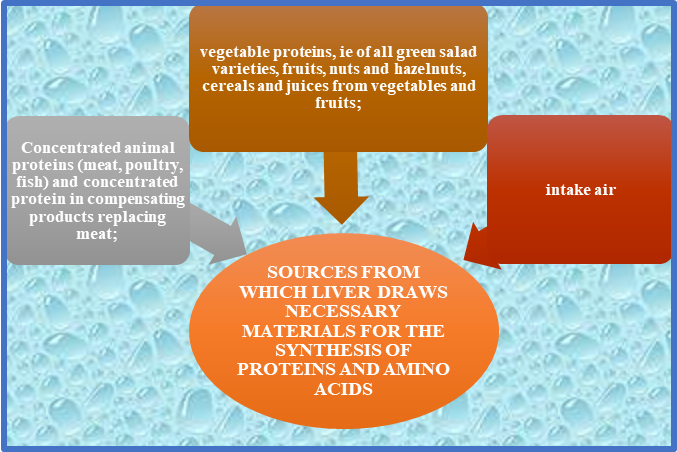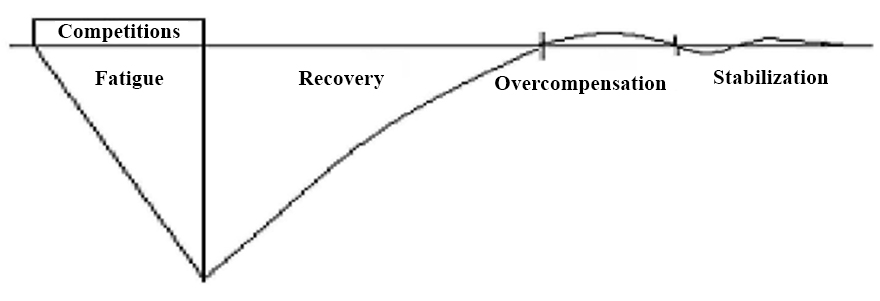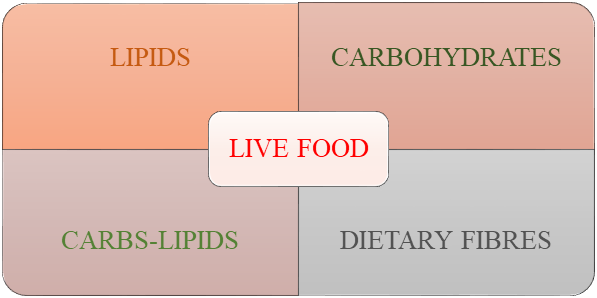Abstract
Recovery begins where the effort ends, so we can define it as a rebalancing, return or regeneration of the body. Systems involved in the recovery process are those that maintain vital functions: blood pressure, heart rate, body temperature. At the same time, the internal environment is restored, the lactic acid accumulates, the accumulation of changes in the blood pH restoring the normal level of sugar in the blood. After a dynamic effort of maximal intensity and after short static efforts, it is necessary to restore the functions of the musculoskeletal system and CNS. When planning training efforts and competitive regimes, consideration is also given to the correlation between work and rest, in order for the subsequent efforts to return to the baseline stage or until the complete recovery. The aim of the research is to achieve personalised recovery through nutrition according to the chosen sport, paying attention to the energy needs demanded by the international competitions. The objectives of the research will be to change the mentality on nutritional factors before training, and the results recorded by the athletes will be based on scientific evidence of sports nutrition. Thus, the management of the recovery process with pharmaceutical preparations in the intensive training period requires the administration of a complex of potash and inosine, but they should be administered only on the doctor’s advice, in the case of maximal intensity efforts at medium altitude and only if the athlete’s functional condition is getting worse.
Keywords: Trainingrecoveryeffortnutritionpharmaceutical preparations
Introduction
Recovery process can occur during the effort (especially of variable intensity), but especially after its completion. If the process of decomposition (of substances) predominates during the effort, during the recovery, the assimilation ones prevail, which contributes to the restoration of spent energy resources.
Recovery is a transitive process during which the body passes from the state of effort to rest. This is a heterochronous process, because the various functions of the body get through rest at different times and different speeds. One of the first recovery processes that occur in the early days is the process of eliminating the oxygen deficiency, and in the late ones, the recovery of the whole organism takes place. The frequency of cardiac contractions, frequency of breathing, blood pressure, systolic volume and minute-volume of blood, blood pH, depth and minute-breath volume, electrocardiogram and encephalogram indices recover and, after that, the dilation of peripheral vessels is rapidly re-established; to recover the amount of haemoglobin in the blood, the number of erythrocytes and leucocytes, several hours and even days are required (to recover the latter ones after a high and moderate effort, 2-3 days are necessary and, in some cases, up to 7 days). The initial level of substance exchange and the volume of maximal oxygen consumption (MOC) are restored within a few days.
Problem Statement
In the recovery process, the physiological mechanisms are directed to restoring the functions of the central nervous system and homeostasis. At the same time, the recovery of the internal environment, the removal of accumulated lactic acid, the changes in the blood pH, the recovery of the normal blood sugar level occur. There is a return to the initial level of blood pressure and body temperature. The damaged function of the internal secretion glands recovers: the secretion of hypophysis adrenocorticotropic hormone, androgens from the adrenal and sexual glands, thyroxin from the thyroid gland and insulin from the pancreas increase. In the liver, glycogen deposition is increasing, which complements the energy resource deposits. Protein reserves in nerve cells and glial cells that surround them, excitability and lability of neurons are recovered.
Research Questions
The objectives of the research will be to change the mentality about nutritional factors before training or signing up for an important competition, and the results recorded by the athletes will be based on a current model supported by scientific evidence of sports nutrition.
Purpose of the Study
The aim of the research is to make a personalised recovery program through nutrition according to the chosen sport, paying attention to the energy needs demanded by international competitions.
Research Methods
The methods used in this research are reflected through: analysis and generalisation of data concerning methodological-scientific sources, observation and pedagogical monitoring, graphical interpretation.
Findings
There are two phases of recovery:
Reduced physical performance phase (from the end of effort till initial level recovery);
Increased physical performance or overcompensation phase.
The manifestation of these phases may change in various conditions: thus, in young athletes, in the case of a low level of training accompanied by increased fatigue, the manifestation of the first phase is increased and the manifestation of the second phase is reduced, and when the level of training is high, the duration of the first phase is reduced and the duration of the second one is increased.
The recovery after a different intensity effort has some peculiarities. After a dynamic effort of maximal intensity and after short static efforts, it is necessary to restore the functions of the musculoskeletal system and central nervous system (CNS). After a dynamic effort of submaximal intensity, besides the recovery of CNS functions, it is necessary to reduce the oxygen deficiency and normalise the internal environment (first of all, the blood pH). After a dynamic effort of high intensity, special importance is given to the cardiorespiratory system functions in order to eliminate the oxygen deficiency, as well as the functions of the internal secretion glands. After a dynamic effort of moderate intensity, it is necessary to suppress the supraliminal CNS inhibition to recover the energy resources (carbohydrate and lipid reserves).
In order to boost the recovery processes, breathing oxygen-rich air (up to 65-75%), oxygenated cocktails, steam and non-steam baths, massage, high calorie food and vitaminisation are applied. Of particular importance is the active rest – the transfer of effort to other muscle groups, as well as the transition from intellectual efforts to physical ones and vice versa: from physical to intellectual ones.
In the planning of training efforts and competitive regimes, the correlation between effort and rest is also taken into account, in order for the subsequent efforts to return to the over recovery phase or the complete recovery. This ensures increased efficiency (Manolachi, 2018; Potop, Jurat, Buftea, & Dorgan, 2017).
Pedagogical means of recovery have decisive opportunities, since errors in the training methodology or inappropriate alternation of rest efforts cannot be remedied by means and methods of recovery. Therefore, strict adherence to the training and rest regime, alternating intensive microcycles with recovery cycles, are essential prerequisites for preventing chronic fatigue.
In the training of athletes for individual events, it is planned to pay more attention to recovery measures aimed at optimising the functional condition of the neuromuscular system and the mental sphere (Manolachi, 2018; Toma-Urichianu, Gagea, Păunescu. & Dima, 2014).
Daily caloric intake of athletes should be 65-70 kcal/kg of body weight, with an optimal ratio of proteins, lipids and carbohydrates (1.0: 0.8: 4.0). To ensure a balanced diet in the stages of preparation, foods rich in vitamins, proteins and carbohydrates are necessary.
During the medium altitude training, it is necessary to feed athletes with foods rich in iron in glutamic acid.
In the case of sleep disorders, food containing tranquilisers is administered. Thus, we propose the recovery after a maximal effort to be carried out by combining the right foods that contain the necessary energy to speed up the operative recovery.
If the nutritionist plans food rations, there is usually a need for processing a fairly large amount of information, depending on the current nutrition requirements of the athlete’s diet. As has been demonstrated in the field, it is rational to use the menu, as a basis for certain complex products, balanced from the point of view of essential food factors. We present three product complexes of different calorific values, which should be considered when planning the energy expenditure (Table
Each of these components is a generalised representative of the respective product group:
There are three sources from which the liver extracts the material required for the synthesis of proteins and amino acids (Figure

The third source - the air - is known by any living being, but is often neglected, not understood, nor respected as a necessary source of protein. The air we breathe contains about 78% nitrogen and 21% oxygen, and nitrogen, as we know, is the main component of all amino acids and proteins (Walker, 2014).
To determine the role of proteins in the nourishment, it is absolutely important to know that neither functionally nor plastically can be replaced with other foods, but they can replace lipids and carbohydrates.
Besides proteins, these products contain many vitamins, the richest of which are liver, eggs, fresh meat and dairy products. Pork, poultry, dairy products contain indispensable factors - phospholipids and unsaturated lipid acids. The products in these groups also contain a large amount of readily digestible compounds – calcium, phosphorus and iron.
The following three components of these product complexes are lipids of animal and vegetable origin. The biological value of lipids is determined, first and foremost, by their high calorific value and the content of polyunsaturated fatty acids in them. Most are contained in unrefined vegetable oils of sunflower, corn, cotton, olive etc. With lipids, the body also receives lipid-soluble vitamins A, D, E, F, K.
Foods like grouts, flour, bakery products, pasta, cakes, potatoes, honey contain an increased amount of carbohydrates, so their main role is to provide the body with energy.
Easily digestible carbohydrates (fruits in their own juice, cakes, honey) should account for about 20% of the total carbohydrate in the food ration. However, the main carbohydrate meal needs to be ensured by the consumption of polysaccharides, which are contained in large quantities in grouts, bakery products, potatoes, pasta and others. These products also contain a considerable amount of mineral substances, being the main sources of vegetable protein (except for potatoes). Baked wholemeal bread, buckwheat, oats are rich in B, PP vitamin group.
In sports nutrition, it is necessary to include a large amount of vegetables and fruits. During intense muscular effort, a large amount of acids are formed in the body, namely fruits and vegetables, being essential suppliers of alkaline equivalents, play an important role in normalising the acid-base balance.
In addition, they serve as essential sources of vitamin C, P, pro-vitamin A - carotene, vitamins from group B, mineral salts, microelements (cobalt, manganese, nickel, iodine, fluorine, zinc, copper etc.) and carbohydrates, which helps regulate digestion processes, enhancing the ability to assimilate different nutrients.
If some products included in these complexes are missing, they can be replaced without affecting the chemical content of the ration. The reciprocal substitution capability of some of these products is shown in Table
The ration of an athlete requiring an energy consumption of 6500-7000 kcal contains a large amount (as volume and weight) of food. This is particularly noticeable when the diet is strictly balanced in terms of indispensable factors, which is, obviously, absolutely necessary. For example, a canoe athlete must consume within one day: 500 g of meat, 100 g of salami, 100 g of fish, 1 litre of dairy products, 1 kg of fruit, 0.8 litres of juices, 700 g of vegetables, 400 g of bread and so on.
Assimilation of such a quantity of food in 3-4 meals is difficult, especially if multiple training takes place within a reduced time. Therefore, if physical exercise is done 2-3 times a day, the number of meals should be increased up to 5-6 times. In the case of long and repeated physical efforts, it is recommended that athletes eat more often in small quantities. In such a regime, it becomes necessary for athletes to consume special products of increased biological value. Such products are assimilated and quickly removed from the stomach. Table
There is an opinion (which has already been confirmed in experiments with judokas) according to which the speed of food movement in the digestive tract of athletes is higher than in the case of people who do not practice sport. It is also known that amid a neuro-emotional effort, food may be retained in the stomach up to 1.5-2 times more than in the resting state.
Distribution of rations over a day must be done in strict accordance with its regime and character. Table
More rigorous surveillance of athletes’ nutrition should be done during competitions. It is unacceptable to participate in competitions on an empty stomach. When compiling the menu for competitive days, it is advisable to increase the specific caloric power of daily food rations in order to reduce their volumes. Nutrition during this period should mainly include proteins and carbohydrates. In the last period, it is important to increase the amount of carbohydrate in the food rations on the eve and during the competition, especially in sports that require increased resistance.
Recovery after effort is not only the restoration of functions at the initial level, but also their improvement through the phase of effort capacity reduction, restoration, super-compensation and, last but not least, stabilisation (Figure

During the recovery phase, it is carried out the normalisation of functions - restoration of homeostasis, completion of energy resources, stabilisation - rebuilding of cellular structures, as well as of fermentation systems.
If we want to become vigorous, vibrant and have an adequate sporting form, we need to feed ourselves with ecological food (raw fruits and vegetables) (Figure

The sequential rule we propose is based on the theory that the most digestible foods will be consumed before the more complex workouts. The goal is to maintain a descendant steady flux of foods to the bowel to avoid blockages. Problems start when different types of foods, which require different processing times and distinct enzymes, collide with foods from other groups. Foods can be divided according to their destination, how much water they contain, the complexity of fats, carbohydrates and proteins. Mixing foods from different categories and of distinct densities complicates the digestive process and slows down the whole metabolism.
Juice → Fruits → Cereal
Drink → Fruits, vegetables or salad → Cereal, bean, meat, poultry meat, fish
Drink → Salad → Main course (cereal, bean, meat, poultry meat, fish) with vegetables. In general, any combination within the same family is considered to be beneficial (Table
We would like to mention that the biggest energy consumption takes place in the digestion of food, because the performer-athlete does not feed properly, that is why it was designed a model nutrition regimen for the period of a weekly microcycle of judokas.
Conclusion
-
The issue of nutrition occupies one of the main places in the training system of professional athletes, because rationally organized nutrition based on natural substances also contributes to strengthening health, increasing exercise capacity, speeding up recovery processes, adapting to physical efforts and, last but not least, perfecting sports mastery.
-
The performance athlete’s diet must:
-
correspond to the energy consumption in the given period of training or competition;
-
be combined with the necessary nutrients: lipids, carbohydrates, dietary fibres etc.;
-
contain both animal and vegetable origin foodstuff;
-
be easily assimilated by the body of the athlete.
-
-
A rational diet can considerably contribute to improving the health state of athletes, and not only, optimising the processes that take place and vice versa, including occurred illness or trauma.
-
The proposed weekly model was piloted by performance judokas and, as a result, there have been recorded international rank results (restoration of homeostasis, completion of energy resources, stabilisation - reconstruction of cellular structures, as well as fermentation systems).
References
- Manolachi, V. (2018). Teoria și didactica sportului feminin (evaluare, planificare, dirijare și nutriție) (Monografie). București: Discobolul.
- Manolachi, V. (2018). Development of managerial skills and sports management to future sports specialists. The European Proceedings of Social & Behavioural Sciences ICPESK 2017, XXXVI, 383-388. Retrieved from http://dx.doi.org/10.15405/epsbs.2018.03.51
- Menrath, D. (2016). Hrană pentru viață. Miracolul vindecării prin alimentație și puterea minții. Snagov: Benefica Internațional.
- Meyerowitz, S. (2010). Combinarea alimentelor și digestia. 101 modalități prin care să-ți îmbunătățești digestia. Otopeni: Benefica.
- Potop, V., Jurat, V., Buftea, V., & Dorgan, V. (2017). Use of the e-training in mathematical modelling of the biomechanical characteristics of double back somersault on the floor. In The 13th International Scientific Conference eLearning and Software for Education, April 27-28, 2017 (pp. 194-199). Bucharest: “Carol I” National Defence University. DOI:10.12753/2066-026X-17-202
- Toma-Urichianu, S., Gagea, G., Păunescu, M., & Dima, M. (2014). The issue of attracting students to the practice of sports. Revista de Cercetare și Intervenție Socială, 45, 31-44.
- Walker, N. W. (2014). La mulți ani. Sfaturile unui medic care a trăit 116 ani. Cum să ai o viață lungă și sănătoasă. Chișinău.
Copyright information

This work is licensed under a Creative Commons Attribution-NonCommercial-NoDerivatives 4.0 International License.
About this article
Publication Date
16 February 2019
Article Doi
eBook ISBN
978-1-80296-054-9
Publisher
Future Academy
Volume
55
Print ISBN (optional)
-
Edition Number
1st Edition
Pages
1-752
Subjects
Sports, sport science, physical education
Cite this article as:
Manolachi, V. (2019). Recovery System After Training And Competitive Efforts. In V. Grigore, M. Stănescu, M. Stoicescu, & L. Popescu (Eds.), Education and Sports Science in the 21st Century, vol 55. European Proceedings of Social and Behavioural Sciences (pp. 497-506). Future Academy. https://doi.org/10.15405/epsbs.2019.02.62
